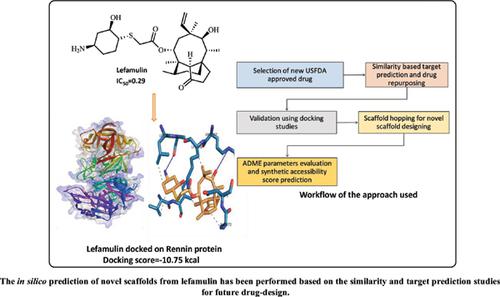Letters in Drug Design & Discovery ( IF 1.2 ) Pub Date : 2021-06-30 , DOI: 10.2174/1570180817999201201113712 Shikha Sharma 1 , Shweta Sharma 2 , Vaishali Pathak 1 , Parwinder Kaur 1 , Rajesh Kumar Singh 3

|
Aim: To investigate and validate the potential target proteins for drug repurposing of newly FDA approved antibacterial drug.
Background: Drug repurposing is the process of assigning indications for drugs other than the one(s) that they were initially developed for. Discovery of entirely new indications from already approved drugs is highly lucrative as it minimizes the pipeline of the drug development process by reducing time and cost. In silico driven technologies have made it possible to analyze molecules for different target proteins which are not yet explored.
Objective: To analyze possible target proteins for drug repurposing of lefamulin and their validation. Also, in silico prediction of novel scaffolds from lefamulin has been performed for assisting medicinal chemists in future drug design.
Methods: A similarity-based prediction tool was employed for predicting target protein and further investigated using docking studies on PDB ID: 2V16. Besides, various in silico tools were employed for the prediction of novel scaffolds from lefamulin using scaffold hopping technique followed by evaluation with various in silico parameters viz., ADME, synthetic accessibility and PAINS.
Results: Based on the similarity and target prediction studies, renin is found as the most probable target protein for lefamulin. Further, validation studies using docking of lefamulin revealed the significant interactions of lefamulin with the binding pocket of the target protein. Also, three novel scaffolds were predicted using the scaffold hopping technique and found to be in the limit to reduce the chances of drug failure in the physiological system during the last stage approval process.
Conclusion: In the future, lefamulin may assist in the development of the renin inhibitors, and also, three possible novel scaffolds with a good pharmacokinetic profile can be developed into renin inhibitors and for bacterial infections.
中文翻译:

使用基于相似性的目标预测、对接研究和 Lefamulin 的支架跳跃的药物再利用
目的:研究和验证FDA新批准的抗菌药物的药物再利用的潜在靶蛋白。
背景:药物再利用是为除最初开发的药物以外的药物分配适应症的过程。从已经批准的药物中发现全新的适应症是非常有利可图的,因为它通过减少时间和成本来最大限度地减少药物开发过程的管道。计算机驱动技术使分析尚未探索的不同目标蛋白质的分子成为可能。
目的:分析来法莫林药物再利用的可能靶蛋白及其验证。此外,已经对来自 lefamulin 的新型支架进行了计算机模拟预测,以协助药物化学家进行未来的药物设计。
方法:采用基于相似性的预测工具来预测目标蛋白,并使用对 PDB ID:2V16 的对接研究进行进一步研究。此外,还使用了各种计算机工具来使用支架跳跃技术预测来自 lefamulin 的新型支架,然后使用各种计算机参数进行评估,即 ADME、合成可及性和 PAINS。
结果:基于相似性和靶标预测研究,肾素被认为是lefamulin最可能的靶蛋白。此外,使用 lefamulin 对接的验证研究揭示了 lefamulin 与靶蛋白结合口袋的显着相互作用。此外,使用支架跳跃技术预测了三种新型支架,发现在最后阶段的批准过程中,可以最大限度地减少生理系统中药物失效的机会。
结论:在未来,lefamulin 可能有助于肾素抑制剂的开发,此外,三种可能的具有良好药代动力学特征的新型支架可以开发成肾素抑制剂和用于细菌感染。











































 京公网安备 11010802027423号
京公网安备 11010802027423号